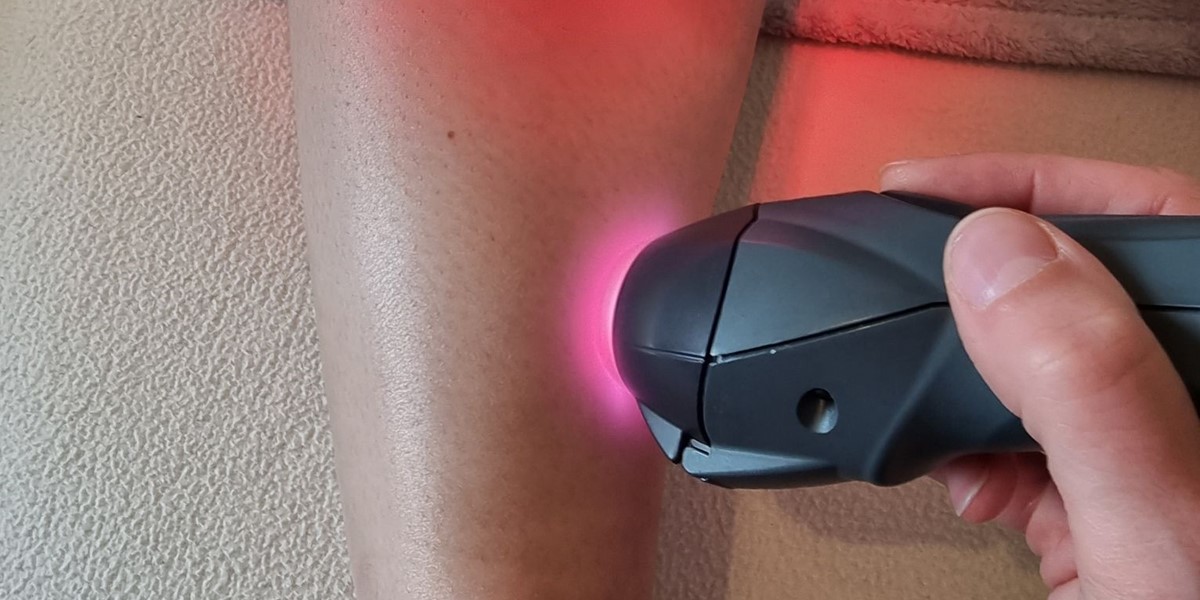Find out more about how this website uses cookies to enhance your browsing experience.
MLS® Laser in the treatment of a muscle tear associated with a grade 3 Achilles tendon rupture

Case History Overview
Claire, a 44 year old female (who is a qualified but non practicing Podiatrist), suffered a grade 3 achilles tendon rupture during a game of netball.
Treatment provided was an aircast walker boot with wedging which was gradually reduced over the course of 2 months. After 8/9 weeks Claire stopped wearing the boot but her “recovery had plateaued”. She explained that, “I hadn’t realised that during the time in the airboot a bad tear to my soleus, that had occurred at the same time as the achilles rupture (but was not recognised/diagnosed), was solidifying into a hard mass”.
Having ruptured the contralateral achilles tendon a few years prior, she was able to compare her previous recovery to her progress this time and once she stopped wearing the boot, she realised her recovery was not where it should be. She found herself (at 2 months post injury) unable to walk without crutches, unable to perform heel raises, going up and down stairs was very challenging for her, she was unable to drive and she was developing debilitating hip pain as a result of her altered movement patterns. She reported “no knee bend and soleus wouldn’t budge”, meaning she was unable to achieve any dorsiflexion or anterior movement of her leg over her foot and therefore had no forwards propulsion.
She had sought treatment from a physiotherapist who had provided her with a comprehensive exercise plan and had attempted massage over the area of the soleus injury which Claire found to be acutely painful. The badly healed soleus tear was causing a significant tightness within the posterior calf, preventing her from getting her heel comfortably in ground contact and creating a painful pull on the achilles insertion at the posterior calcaneum.
When Claire contacted me to enquire about laser treatment, whilst her achilles tear had healed, she believed that surgery was going to be the only realistic option to fix her soleus and that her recovery was going to be prolonged. She was feeling very down about her lack of progress and the long road she could see ahead.
She had to be driven to her first appointment as she was unable to drive herself and emerged from the car using a crutch. She presented with an acutely painful tissue lump over the muscle belly of soleus which measured approximately 10cm x 5cm.
Treatment
Claire received a total of 5 treatment sessions – two were completed in the first week and the subsequent sessions were done weekly. Treatment was delivered using the MLS Mphi 5 laser which allows for the treatment of 2 different areas simultaneously.

During each session the multi diode applicator (with 5cm diameter treatment area) was used to target the heads of the gastrocnemius and soleus muscles with the goal of reducing any contraction proximal to the injured area of the soleus. At the same time, the hand piece (with 2cm diameter treatment area) was used to focus on specific points of contracture on the soleus in the area of the injury using ‘point mode’*. Finally, the trigger point setting was used to target specific pain points which were palpated in the proximal and surrounding tissues. Total treatment time was approximately 25 minutes.

*Because of the MLS lasers unique nanopulse technology, the risk of thermal damage is negated and clinicians can use point mode, where the laser is held stationary over specific treatment areas for a pre-determined length of time allowing a deep and effective treatment of each point.
Between treatment sessions, Claire did yoga to stretch the muscles of the posterior calves, as well as the exercises prescribed by her physiotherapist.
Treatment Outcomes
After the first treatment session, before she had stood up off the treatment couch, Claire noticed an immediate improvement in her pain levels and an increase in the range of motion through her ankle, with a visible reduction in the contracted lump of the soleus muscle. When she returned for her second session 3 days after the first, Claire drove by herself and was walking without a crutch. When Claire attended a physiotherapy appointment 2 weeks after her first laser session, the physiotherapist she had seen previously was “blown away” by her progress in such a short period of time and by how much the mass in the soleus had reduced.
In Claire’s own words, “immediately after the first treatment I had a range of motion in my ankle that I hadn’t had for months. I was able to do my strengthening exercises, within two days I was able to walk unaided and get back to driving. After another 4 treatments the solid lump is a fraction of the size. I’m back cycling and the strength and ROM continues to build What I’m sure would have taken me several months of massage treatment to break down has happened within 2-3 weeks and I’ve managed to get my independence back. Being able to walk unaided, drive, do all the day to day tasks that being a mum involves as well as getting back to being able to travel for work has been a game changer. I can’t believe the laser treatment has been as successful as it has been.”
A very satisfactory outcome for both patient and podiatrist.
Find out more about the MLS® Laser FREE four week trial opportunity here
- Kirsten Sinclair, BScPod, HCPC reg.